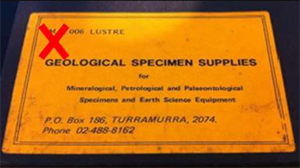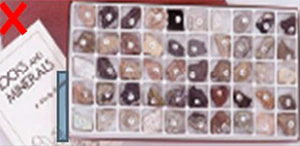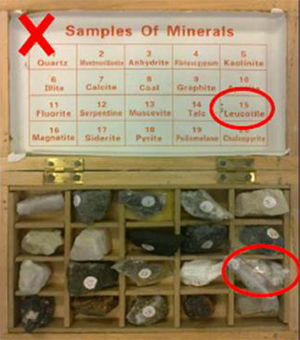This safety alert is to advise of the reported presence of asbestos rock samples contained in some mineral kits purchased by schools. These kits have been sold throughout Australia and continue to be available for sale online.
Mineral kits

Some mineral kits have been found to contain asbestos under a variety of names, including serpentine, amosite, tremolite and chrysotile, occasionally referred to by the name of leucotile.
Some earlier mineral kits (dating from the 1970s) produced by the former Geological Specimen Supplies company may also contain asbestos. The 'Lustre' mineral kits may include the blue asbestos mineral crocidolite as an example of fibrous lustre.

Kits which contain any of the samples listed below should be treated as containing asbestos or other hazardous mineral fibres and withdrawn from use.
Names of geological samples that are not to be purchased:
- actinolite
- actinolite
- amphibole
- amosite (grunerite)
- anthophyllite
- asbestos
- chrysotile (leucotile/white asbestos/ chrysotile serpentine)
- crocidolite (Blue asbestos/ Riebeckite)
- fibrous zeolite including erionite and offretite
- richterite
- serpentine or serpentinite, including lizardite and antigorite serpentines
- tremolite
- winchite.

Recommended action
It is suggested that a review of all mineral kits and geological samples be undertaken. Schools are advised to implement the following steps:
- Immediately suspend use of all kits or samples that have not previously been confirmed as asbestos free.
- Follow your school’s safety management plan for notification and dealing with this situation.
- If you have the supplier details, contact them to confirm whether your kit/sample contains asbestos or mineral talc that may be contaminated with asbestos (for example, ask to see a testing certificate) and arrange for a return or replacement of the kit/sample if necessary.
- If the supplier is unknown and you aren’t sure about whether a kit listed in table 1 contains asbestos, you have the following options:
- Have the sample tested for the presence of asbestos. If confirmed to be asbestos, dispose of the geological samples as asbestos waste; or
- Treat all samples as potentially containing asbestos and dispose of as asbestos waste.
- If not returned to the supplier, affected products should be taken to an asbestos disposal facility. Your nearest facility can be located on the Asbestos and Silica Safety and Eradication Agency (ASSEA) website.
Disposal of asbestos waste
In line with good practice procedures in handling asbestos containing materials, it is recommended that the kits or individual samples of mineral talc or rocks be placed in a plastic bag, such as a zip lock bag or in the original packaging if possible, for return or disposal. If the kit is undisturbed and intact, Personal Protective Equipment is not required.
Kits containing a sample labelled as ‘leucotile’ are being recalled on a voluntary basis by the supplier. Suppliers will manage the recall process directly with schools. The whole kit is to be recalled; not just the leucotile sample.
Schools should not assume that kits are asbestos free. Therefore, before purchasing kits or samples, schools should request certification confirming that the product has been tested and does not contain asbestos. Document this instruction for any future acquisitions. Note: a number of suppliers are already providing this certification.
A pre-purchase check should be undertaken for all mineral, geological and ore kits or samples including:
- cleavage kits
- crystal habit kits
- fluorescence and phosphorescence kits
- igneous, metamorphic and sedimentary rock and mineral kits
- individual geological specimens
- lustre kits
- (Moh’s) hardness kits
- specific gravity kits
- streak kits.
Mineral Talc
Concern has been raised about the possibility of mineral talc being contaminated with asbestos.
Mineral talc and asbestos minerals can sometimes geologically occur together, and it is possible that mineral talc specimens could be contaminated with some asbestos fibres, however the risk of asbestos contamination from this source is considered to be very low.
Risk of exposure to asbestos fibres
Asbestos may be present in many geological samples in varying physical forms.
Health risks associated with asbestos exposure relate to the inhalation (breathing in) of fibres. If asbestos material has not been disturbed it is unlikely to release asbestos fibres. Accordingly, any potential risk of exposure to asbestos is considered to be low.
Testing for asbestos
Testing can confirm whether the material contains asbestos or not. It is recommended that a National Association of Testing Authorities (NATA) accredited laboratory be used. The Australian Standard AS 4964 Method for the Qualitative identification of asbestos in bulk samples may be used or an equivalent method. Some non-NATA laboratories may also be able to undertake testing according to AS 4964 if a NATA laboratory is not readily available.
Stopping goods with asbestos from entering Australia
The Department of Immigration and Border Protection and the Australian Border Force (ABF) continue to target entities, including particular manufacturers and certain import and distribution companies, both overseas and in Australia at risk of importing products likely to contain asbestos.
Any information about imported products of concern can be reported to the Department of Immigration and Border Protection on 1800 009 623. Concerns about products available in retail shops or questions about the handling of products that have been found to contain asbestos should be addressed to the relevant State/Territory workplace health and safety authority.
Resources
This alert was developed by the Heads of Workplace Safety Authorities (HWSA) Imported Materials with Asbestos Working Group, whose membership comprises representatives from: Asbestos and Silica Safety and Eradication Agency, Workplace Health and Safety Queensland, Australian Competition & Consumer Commission, WorkSafe Australian Capital Territory, Department of Immigration and Border Protection, Northern Territory WorkSafe, SafeWork SA, WorkSafe Tasmania, Safe Work Australia, WorkSafe Victoria, Safe Work NSW, WorkSafe Western Australia.
First published in November 2015
